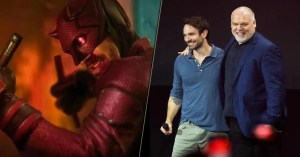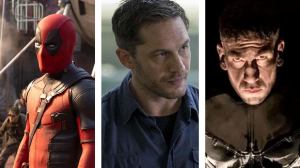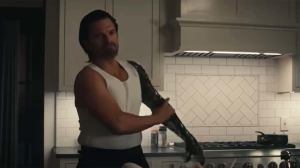“The price of freedom is high, it always has been. And it’s a price I’m willing to pay. And if I’m the only one, then so be it.” – Steve Rogers.
The Falcon and the Winter Soldier used those words in trailers leading up to the series, as Anthony Mackie‘s Sam Wilson weighs the legacy of a hero by remembering Steve Rogers’ speech in Captain America: The Winter Soldier, which is cribbed from John F. Kennedy. It’s a new day in the MCU and Sam’s understandably confused about how to move forward with that legacy. However, Sam becoming a Black Captain America isn’t the first time a black man has wielded a star-spangled shield in a country that hasn’t always been hospitable to people who look like him. Years before Sam or Steve took up this fight, a man named Isaiah Bradley took a leap of faith. He was the first Black Captain America, and his entire squad paid the price for freedom back at home. In The Falcon and the Winter Soldier episode 2, the tragic history of Isaiah Bradley and the Black Captain America comes crashing into the Marvel Cinematic Universe.
Videos by ComicBook.com
Truth: Red, White & Black is a 2003 limited series written by Robert Morales with art by Kyle Baker. Across seven issues, they tell the story of Bradley and how he became the first Captain America. Marvel publisher Bill Jemas had a comment about a Black version of the character and then editor Axel Alonso was encouraged to develop it further. It wasn’t long before the creative team and the company thought the best way to pursue the story was a historical allegory, and one event people might not be aware of: The Tuskegee Study of 1932.

For those who don’t know about this part of American history, in 1932 The Tuskegee Study of Untreated Syphilis in the Negro Male saw the U.S. Public Health Service green light a program to observe 600 Black men under the pretense of treating the disease. 399 of them had it and were told by researchers that they were getting treatment to possibly cure them. However, the study would go on for 40 years, despite penicillin becoming the common treatment for the disease in 1947. Many of them would die and the real social awareness of the situation wouldn’t be in the news until 1972.
One of the prevailing comments about the Super Soldier serum that gave Steve Rogers his powers was that scientists of the time would have never tested it on the man who would be Captain America first. Despite him being read as “undesirable” for a soldier of the era, it would make sense to believe that the doctors in charge would have experimented on Black subjects first. This directly influences Bradley’s experiences in the book with his 299 fellow soldiers being experimented on.
Despite the horror of all of his squadmates meeting a sad end far from their neighborhoods, Bradley is determined to fulfill his mission. He’s seen his friends insulted and literally beaten by other officers at Camp Cathcart in Mississippi. There was the torture, the fact that the soldiers’ families were told they died in a training accident, and the overt racism to contend with. Despite all of that, he fights to return home as Captain America and even wears the costume himself.

Upon returning home, there are no thanks, no “job well done.” Instead, Bradley is imprisoned and spends 17 years in solitary confinement. The super-soldier is court-martialed and held at Leavenworth Federal penitentiary. If that weren’t enough, the serum has after-effects that severely limit Bradley’s cognitive function. Despite all of this, he remains physically whole despite the decline in his mental health.
The man is treated as a hero by the Black community. He’s some sort of urban legend to younger Black heroes, and that’s how Steve Rogers eventually learns about him. The Captain America we all know is touched by this sacrifice and horrified that no one informed him of Bradley’s existence before the 2000s. In the face of legitimate mistreatment, the hero is still happy to meet the other Captain America. Nothing is about to make up for that abuse and mistreatment. The only thing Steve can do, ironically, is to make room for him in his own way as living proof of the ideal he’s worked his entire life to uphold.
In the same token, it’s important to note that Bradley is not given his title of “Captain America” back when Rogers presents him with the costume that was thought lost during the war. Instead, the exchange reads like someone stumbling upon a parcel and delivering it to its original owner — with the sly, intended note of the dream being a bit worse for wear after all these decades.
Despite those tatters, Bradley stands as a true symbol of giving everything to help a country that tried to sabotage what he held dear. His wife is alive and thriving with a robust support system. In this respect, the Black Captain America is a living testament to those words Rogers spoke in Winter Soldier; selflessness, even to his own detriment. Sam Wilson is going to be the first Black Captain America on screen, but learning this story and figuring out how to carry both Rogers’ and Bradley’s legacies will be the biggest challenge in The Falcon and the Winter Soldier.
We don’t know if the MCU tracks to our reality one-to-one. But, if Sam Wilson’s world has a Tuskegee Study or the Super Soldier trials that caused all that suffering for Black soldiers, it would probably shake his core in ways that Rogers couldn’t begin to comprehend. Yes, Steve stood up to Hydra, aliens, and even Iron Man when he felt it was necessary. But, how does the story look when the lines aren’t so cut and drawn. How does Steve react if there are some American citizens that get hurt at the beginning of Civil War rather than people from Lagos? One of Sam’s biggest challenges is going to be the balance he has to maintain as a legendary hero in his own right.
The Falcon faces one challenge his Black predecessor did as well. For some, they’re never going to be Captain America. The commanding officers laugh at Bradley’s regiment when anyone even feigns concern about their wellbeing. It is in the text that they’re more upset about the soldier stealing the uniform than they are about the possible loss of a Super Soldier. In the same weird way, a lot of the dialogue about The Falcon and the Winter Soldier has revolved around a disc-shaped piece of vibranium and not the man wielding it.
For the MCU series to really do TRUTH justice, it will have to grapple with the questions of what symbols can really do. Can that shield still be a force for justice in the hands of a minority hero? Sam Wilson probably thinks so, and that’s why he got himself turned into a pile of dust following Steve Rogers into battle. But, The Falcon will be learning some of the same lessons that Bradley did decades ago. Those wounds are still deep and have been allowed to fester all these years. The only way to truly heal them is to let them breathe out in the light of day. For Sam and for the MCU, that’s the best way forward.
The Falcon and the Winter Soldier debuts on Disney+ beginning Friday, March 19th.
Want to learn more about the latest Marvel Studios series? Check back on ComicBook CRAM every day leading up to the premiere of The Falcon and the Winter Soldier, and click here for even more articles and videos to find out everything you need to know about the new show!
If you haven’t signed up for Disney+ yet, you can try it out here. Note: If you purchase one of the awesome, independently chosen products featured here, we may earn a small commission from the retailer. Thank you for your support.





